Spain – Tangier – Gibraltar 2010-2011
Years ago I went on a rather unsuccessful windsurfing course on Lanzerote in the Canary Islands, but I had never been to mainland Spain. Almost everyone I knew in England had been there and I felt left out when they were talking about it, so I thought it was time to get some first hand experience of the place.
Most of my trips have been meticulously planned in advance, sometimes down to studying the white lines on the road on Google satellite photographs. This one was different, because due to adverse weather in England and air traffic controllers' strikes in Spain it was uncertain when I would get there, if at all. The only things booked in advance were the flight and rental car as it might have been difficult to get them at short notice.
The plan was to fly to Malaga with easyJet and stay one night along the coast in Nerja with my friends Barbara and Jim, who now spend every winter there to escape from the horrors of the British weather. It would be impolite of me to disclose their ages, but they are quite old.
In the event there was no hold up, and the plane arrived more or less on time. The car was booked through Holiday Autos, whose local agent was an outfit called record go. The lady at the desk gave me the keys to a Ford Focus Diesel, which was parked in the vast multi-storey car park nearby. I spent 20 minutes searching for it before discovering that there was a plan on the papers that I had been given showing exactly where it was. When I examined the car I found a scrape in the bodywork all along one side, not marked on the rental agreement, so I had to walk ¼ mile back to the desk to report it. The lady made the cryptic statement "Oh yes, a lot of our cars are scratched or dented. We don't tell you". I was not very happy about this, but it seemed to be the way they work.
Nerja is about 40 miles east of Malaga, linked by a motorway that runs past the airport. The scenery could probably be best described as a very spectacular urban landscape, with high-density development covering the mountains on both sides, and sea views where the land dropped away on the right. This was my first sight of the Mediterranean since 1959. The satnav led me with unerring accuracy through the narrow streets of Nerja to Calle Malaga, where my friends lived. They were standing in the street waiting for me, and Barbara, who is easily capable of running a medium-sized town single-handed, quickly created a parking space in the street in front of their apartment block.
Nerja has a large ex-pat population, and Barbara and Jim seem to be well-established in the community, with many friends of various nationalities. They showed me round the town, which is quite smart, in fact in retrospect I can say that it was probably the smartest place I saw in Spain. In the evening we went down to the beach, where the waves were breaking over the rocks under floodlight. The temperature was about 15 deg, a very considerable improvement over what I had left behind at Gatwick.
After a walk on the promenade the next morning Jim drove us up to a mountain village called Frigiliana, with steep narrow streets which 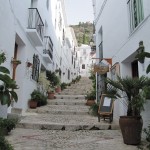 I was to discover are the norm for villages and towns in that part of Spain. Apparently the road up to the village, along with the motorway from Malaga and civic improvements around the beach in Nerja, has been built in recent years with EU money, but this was just a drop in the ocean compared with what I was to see later.
I was to discover are the norm for villages and towns in that part of Spain. Apparently the road up to the village, along with the motorway from Malaga and civic improvements around the beach in Nerja, has been built in recent years with EU money, but this was just a drop in the ocean compared with what I was to see later.
After a tapas meal in Frigiliana I left my friends and drove westwards to Torremolinos, taking the coast road rather than the motorway as far as Malaga. The previous evening they had asked me where I was going from Nerja, and I just wish I had a photograph of their faces when I said "Torremolinos". 'Terrible Torrie' as it used to be known, with its reputation for providing package holidaymakers with a roaring good time, would not give me the image of Spain that they would like me to have. However, I pointed out that I go to places to find out what they are like, not to find that they are nice, and intended to get a wider overview of the area in due course.
There was little traffic on the coast road, which runs very close to the beach in some places, but the drive was spoilt by endless road humps, which are a feature of all the urban areas that I went to. Round Malaga and on to Torremolinos the only practical route was to go up to the Carretera Nacional N340, which is one of the most dangerous roads in Europe. It is the main highway through the Costa del Sol, although for some stretches there is a parallel toll motorway, with more under construction. The N340 is really an urban dual carriageway with no hard shoulders and many entry and exit points, as well as bus stop lay-bys. There are no slip roads at most of the junctions, which means that vehicles are often entering the road from a standstill, and have to slow down to a very low speed to turn off, so with speed limits of 80 or 100kph it is no surprise that there are a lot of accidents.
The centre of Torremolinos is not far from the N340, and I followed signs to a hotel called the ROC Flamingo. It looked quite good by my standards, and had an arrangement for parking with the Carrefour supermarket opposite. My room was on the fifth floor, with a small balcony facing the fifth floor of the next building.
Somehow I had imagined that Torremolinos would be flat, which is far from the case. From the hotel the streets sloped down through the shopping area, and then turned into 99 steps leading to the beach, according to the people in a restaurant. There are a lot of different routes, but they all involve climbing in one form or another, and the lift did not seem to be working. By the time I had got to the beach, walked along it for about ½ mile and found my way back to the hotel via another lot of hills and steps I was worn out.
It was rather surprising, therefore, to find that the several hundred people in the hotel breakfast room in the morning were all aged over 50 with the exception of one, and she was about 40. They certainly didn't look as if they would be living it up into the night in the traditional Torremolinos style, although many of them looked as if they had lived it up pretty well in the past. The breakfast was very comprehensive, with areas laid out to appeal to different national tastes, but in fact the vast majority of people there were Spanish. It appeared that they had arrived by coach, and the hotel had a coach to take them to and from the beach.
From Torremolinos I drove westwards on the N340, stopping to look at Fuengirola, Marbella, Estapona and briefly at Sottogrande. 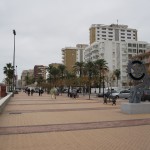 Fuengirola has a large ex-pat British community, with a long promenade lined with cafés offering Fish & Chips, English breakfasts and all the delights of an British seaside resort excepting the winter weather. I have to confess to stopping at a British-run café for a proper cup of tea.
Fuengirola has a large ex-pat British community, with a long promenade lined with cafés offering Fish & Chips, English breakfasts and all the delights of an British seaside resort excepting the winter weather. I have to confess to stopping at a British-run café for a proper cup of tea.
Marbella is a smarter place, but obviously more expensive, and when I asked a Spanish policeman for the way to the nearest toilets he turned out to be English. Parking near the front was £2.20 per hour, so I didn't stay for long. The resort is famous as a retreat for British criminals, and it may be that they are now running the car parks.
Estapona looked a pretty up-market place, although I did not stop, and at Sottogrande the strong cool wind deterred me from staying for long. It was strange, because there was no wind in Marbella, and the temperature there was about 17 deg. There is not much in Sottogrande anyway, apart from the beach and a massive unfinished residential development.
It was my intention to spend a day on Gibraltar (Great Britain) and a day in Tangier (Morocco), but I was not sure of the exact arrangements for getting to either place, and whether the impending New Year might produce complications. The Rough Guide to Andalucia (hereafter referred to as RG) that I had borrowed from Bognor library had quite a lot of information but was several years out  of date, so I decided to go on to Algeciras, a ferry port, and stay the night there.
of date, so I decided to go on to Algeciras, a ferry port, and stay the night there.
On the way the road passes through San Roque, which is very industrial, with a huge oil refinery. It is a fairly depressing place, founded in 1704 by the original inhabitants of Gibraltar when they were driven out by the British. They expected to return within a few years, but that did not happen.
San Roque is, however, bright and cheerful compared with the suburbs of Algeciras, in which I found myself in the course of looking for a hotel. In 1969 Franco closed the border with Gibraltar, cutting off access for the Spanish people who worked in the naval dockyard, and decided to industrialise Algeciras to provide employment for them. Most of the people around appeared to be immigrants from North Africa. The port was easier to find than the town centre, and I eventually got a room in a hotel facing the port entrance. The room was on the 8th floor, with a fabulous view over the town and mountains in the background.
The area was just a bit sleezy, with a definite 'On the Waterfront' sort of atmosphere. In the same block as the hotel were several travel agents, with touts outside trying to sell ferry tickets. For miles before getting to the town I had passed places advertising tickets to Tangier and Ceuta, a Spanish protectorate on the coast of Morocco (a relationship similar to that of Gibraltar to Britain, and the Spanish are just as determined to hang on to it). Judging by the number of people engaged in selling tickets, it must a profitable business.
The hotel had an underground car park in a back street that you would not want to walk down at night, and after putting the car away I made enquiries about the ferries to Tangier. The RG warned about being misled by ruthless ticket sellers, and after getting conflicting information from several travel agents it was clear that for a day return to Tangier I needed to use the fast ferry from Tarifa, about 12 miles to the west.
 The main street was actually not far from the hotel, but I walked in the wrong direction and it took me a long time to find it. It was a great contrast to the dingy port area, with all the shops open until late, more Christmas decorations than in a British high street, and the place was thronging with people. It was hard to believe that the country was in a state of financial crisis.
The main street was actually not far from the hotel, but I walked in the wrong direction and it took me a long time to find it. It was a great contrast to the dingy port area, with all the shops open until late, more Christmas decorations than in a British high street, and the place was thronging with people. It was hard to believe that the country was in a state of financial crisis.
As I stuffed myself full at breakfast time the next morning it did not occur to me that I might be seeing it all again later a few miles off the coast of Morocco. At this stage I did not even know I would be going to Tangier that day, but when I got to Tarifa it was quite straightforward to get a return ticket from the ferry company at the same price as the touts had been asking and after leaving the car (with some reservation) in the street near the harbour I walked to the ferry.
This was a cross-channel style car-carrying catamaran, and was supposed to do the journey in 35 minutes. The passport stamping was carried out in the main cabin by two Moroccan officials, so that passengers could walk straight off the boat on arrival. We started late, and about two-thirds of the way across the sea got quite rough and the vessel was almost flying off the waves. We were actually travelling through the area where the Mediterranean meets the Atlantic, and as Tarifa is now a famous wind-surfing centre, said to be on a par with Hawaii, it is hardly surprising that there were big waves.
In the fifty or more years that I have been using ferries I have always claimed to be a good sailor, but on many occasions it has been demonstrated to me that I am not, and this was one of them. Other people started to be sick, and eventually I had to run to the room labelled Caballeros . The cubicles were all occupied, and as I hung on to the edge of the stainless steel wash basin I think that could be described as the low point of the trip. It was a very sad face that looked back at me from the mirror behind the basin.
The great thing about seasickness, to use a contradiction in terms, is that when it's over, it's over, and by the time I had walked the half mile from the terminal to the port gate in Tangier I had forgotten all about it. It was a bright day, temperature about 23 degrees, as I walked along the promenade after fighting my way past the men selling watches and other items of jewellery just outside the gates. On my previous trip to Morocco, a few years earlier, I had so much hassle from the locals in the desert towns that I said I would not go again, but in a big city like Tangier there is always someone else to whom they can turn their attention if you make it clear that you are not  going to buy.
going to buy.
The only large city I had visited previously in Morocco was Marrakech, which is more or less flat. Tangier is anything but flat, with streets rising steeply up from the sea front. After taking photographs of the beach, with its palm trees, I walked up the hill into the 'modern' business quarter and found a café to replace some of what I had lost on the boat. The area had the chaotic mixture of old and new, with the frantic traffic that is typical of Morocco. A man in the Europcar office directed me to the old part of the city, a longish walk over the hill, and as I came within sight of it I heard the call to prayer. On the way through a shopping area I passed a large tent-like structure in which several men were praying, some in Muslim dress, and some in modern suits. An alley led down steps into the proper souk (market), and it was here that I made rather a bad mistake. I stopped to take a photograph of the market area, with an ancient 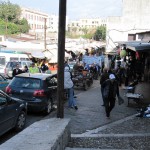 building in the background, without realising that a lady in a burka was walking towards me. As I pressed the button she screamed, put her hands across her eyes and ran for cover into a stall on the side. A torrent of prayers followed as I walked past, and I was annoyed with myself, because I was aware that you have to be careful not to cause offence by photographing people in that situation, and I had simply forgotten. As it happens, she was not in the photograph anyway.
building in the background, without realising that a lady in a burka was walking towards me. As I pressed the button she screamed, put her hands across her eyes and ran for cover into a stall on the side. A torrent of prayers followed as I walked past, and I was annoyed with myself, because I was aware that you have to be careful not to cause offence by photographing people in that situation, and I had simply forgotten. As it happens, she was not in the photograph anyway.
The souk was brilliant, with narrow alleyways between stalls selling everything from electronic equipment to food to household goods to utter rubbish. It is strange how, when you are there, you venture into places that you think you would not go into when you read about them or see them in pictures. In the end I walked down a darker, narrower, muddier alley that I had been along anywhere else in Morocco and it was sad to see the absolute junk that some people were hoping to sell to make a living.
Eventually I emerged into the sunlight, and spent some time looking around the rest of the old town before making my way back to the harbour. There was supposed to be a ferry to Tarifa every hour on the hour, and it was a mystery to me why, as I walked towards the boat exactly on the half hour, the men standing at the bottom of the ramp shouted and waved at me to hurry up. I ran up the ramp just as they started to close the doors, and was worried in case I was on a ferry to somewhere other than Tarifa, but in fact it was correct. It was much larger than the one coming over, like a little ocean liner, with a big glass dome over the main passenger cabin, and completed the crossing very smoothly in the stated 35 minutes.
Tarifa is an EU border and a main entry point for people coming from Africa. It was therefore interesting, but totally predictable, that non-EU passport holders were processed four times more quickly than citizens of EU states.
By now I had decided to visit Gibraltar the next day, before moving on westwards and up into the mountains. Gibraltar was about 25 miles from Tarifa, with Algeciras in between, and I made enquiries about staying in Tarifa, but the hotels seemed rather expensive, so I went back to the Al Mar in Algeciras for the night. This time I was promoted to the 9th floor, with a view of the port and Gibraltar in the background. The port, which is the seventh largest container terminal in Europe and extremely modern, looked like a huge working model from my window and I could have watched it for hours. However, hunger eventually drove me to go out and find a restaurant, and I picked the nearest one to the hotel without realising that it qualified for an entry in the Book of Rip-off Spain. It was not much more than a greasy-spoon café, and a 2-course meal with coffee from the four-language menu came to €20.
The RG advised against taking a car into Gibraltar because of the queues, and recommended leaving it in a car park in La Linea de la Conceptión, and walking through the frontier. The next morning I drove round to La Linea ("The Line"), which is the Spanish town right up against the frontier with Gibraltar, and decided to look for a hotel, so that it would leave the whole day free for exploring the British colony. A quick look around La Linea was enough to determine that it is a pretty depressing place, apparently with a high unemployed immigrant population, and the best bet was the first hotel I came to, about 200 yards from the entrance to Gibraltar. It was expensive and up-market by my standards, but very convenient.
After getting sorted I walked along the road to the frontier. As predicted by the RG, there was a long queue of vehicles, but few pedestrians, and no delay at the passport check. A short distance from the frontier the only road into Gibraltar crosses the main airport 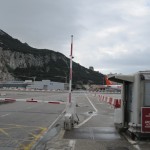 runway, and everyone had to wait a few minutes while an easyJet plane taxied across the road at speed on its take off run.
runway, and everyone had to wait a few minutes while an easyJet plane taxied across the road at speed on its take off run.
The town has an unmistakeable military atmosphere, with utilitarian blocks of flats at first, leading to a square 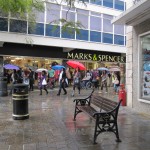 surrounded by traditional naval buildings, and then Main Street, which is lined with shops. These consist mainly of British high street names such as Marks and Spencer, Peacocks, BHS etc., together with a large number of locally-owned shops selling tax-free goods, particularly phones, cameras, computers and other electronic items. All the UK icons are there, red telephone kiosks, pillar boxes and policemen in British uniforms.
surrounded by traditional naval buildings, and then Main Street, which is lined with shops. These consist mainly of British high street names such as Marks and Spencer, Peacocks, BHS etc., together with a large number of locally-owned shops selling tax-free goods, particularly phones, cameras, computers and other electronic items. All the UK icons are there, red telephone kiosks, pillar boxes and policemen in British uniforms.
Fortunately when I got an all-day breakfast in a Sports Bar at the end of Main Street I discovered some English money in my backpack, because the exchange rate for euros in business premises is very poor. What I did not realise until it was too late is that although the coins in the change I was given looked like English ones some of them were Gibraltar ones which cannot be changed outside the colony.
I had picked up a map from the tourist office, and decided to walk up the Rock until I came to the apes, although I had no idea how far that would be. In fact, it was a very long way by my standards, and everybody else seemed to be driving up or going in minibuses. There is a cable car that was closed due to high winds, which seemed rather strange, because where I was there was no wind at all. A fter slogging up the hill for a long time I came to the Jews' Gate, where you had to pay 50p to proceed any further. My knee was starting to give trouble, and I debated whether I was going to be able to walk on far enough to get full value for the 50p, but decided to risk it. Looking down below I was surprised at how high I had climbed, and the views over the naval dock-yard and town were superb. In the distance I could see the port of Algeciras and the mountains beyond, with the mountains of Morocco clearly visible to the south.
fter slogging up the hill for a long time I came to the Jews' Gate, where you had to pay 50p to proceed any further. My knee was starting to give trouble, and I debated whether I was going to be able to walk on far enough to get full value for the 50p, but decided to risk it. Looking down below I was surprised at how high I had climbed, and the views over the naval dock-yard and town were superb. In the distance I could see the port of Algeciras and the mountains beyond, with the mountains of Morocco clearly visible to the south.
After about another ¼ mile I saw a parked car with some things running round it, and realised that I had made it to the apes. They were quite tame, and allowed people to get close to them, but did not really engage with anyone as far as I could see. Certain aspects of their conduct in public left something to be desired, and perhaps the authorities should consider putting up some notices telling them to moderate their behaviour.
Not long after reaching the apes there was a track leading downhill, with a notice saying that it was a military road and led to an apes' habitat. I took it, thinking that it would take me back to the town, and after about 600 yards I came to an old lookout point where the track finished. At that moment an ape came out from behind a rock and looked at me with a broad smile. I smiled back, and then realised that the ape was not actually smiling, it was baring its teeth in preparation for a territorial challenge. It had an awful lot of teeth, far more than I've got, and it seemed wise to withdraw before there was any trouble.
Eventually, after returning to the road and climbing even higher I found a route that really did lead back to the town, finishing on a rough path and then a vast number of steps. Back into scooterland. Motor scooters are the staple transport for a large proportion of the population of Gibraltar, which makes sense considering the limited road mileage and parking space on the colony. Some roads have a wide strip marked along one side for car parking, and a narrow strip on the other side for scooters and motorcycles. In the town centre 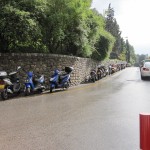 are parking areas full of scooters of every known make and type, like a permanent scooter rally.
are parking areas full of scooters of every known make and type, like a permanent scooter rally.
It was New Year's Eve, and by 5.00pm everything was closing, so I had a snack and bought some food to take back to the hotel, because I did not know whether I would be able to get anything later. My room was on the 5th floor, with a view of Gibraltar town, Rock and airstrip. I was not bothered about not celebrating the New Year, because that is for people who still imagine that the New Year will be better than the old one, and when you get to my age you know it won't be. In the event I was woken at midnight by fireworks, and had a grandstand view of the display in the centre of Gibraltar.
In the morning I set off on the coast road to the west, passing Algeciras again, and stopped for a proper look at Tarifa, which has a historic area within the well-preserved town walls. Moving on westwards on the N340 from Tarifa I came to the largest wind farm I have ever seen, one of the largest in Europe, with over 200 turbines. When the wind is blowing it provides sufficient electricity for the town of Tarifa, but bearing in mind that the town is not very large and has a warm climate, it brings home how unrealistic it is to think that wind energy can ever begin to meet the needs of a whole country. It is on the route taken by migratory birds, and many have fallen victim to the massive blades of the generators.
Tarifa, but bearing in mind that the town is not very large and has a warm climate, it brings home how unrealistic it is to think that wind energy can ever begin to meet the needs of a whole country. It is on the route taken by migratory birds, and many have fallen victim to the massive blades of the generators.
After looking at Facinas, a quaint hill top village overlooking the wind farm, I cut through to Zahara de los Atunes, which had a vast empty car park adjacent to a vast empty beach with nice sand. It was New Year's Day, and everything seemed to be closed, but a few miles further along the coast I came to Barbate, which had a small promenade with a string of cafés, a couple of which were doing meals.
From Barbate I decided to go inland to explore the "pueblos blancos" or white towns, starting with Medina Sidonia and then Arcos de la Frontera, where I planned to stay the night. The road to Medina had been upgraded recently with EU money and was much better than I would have expected for a cross-country route. Medina itself was shaped like a steep sided cone, dominated by a large church at the top. The narrow streets were lined mainly with terraced white houses, characteristic of the white towns, and I set off on foot to explore, but after a short distance realised that I was not going to make it to the top of the hill. Back in the car I drove towards the centre, and turned off to go up the hill, which proved to be much more challenging than I had expected. The road was incredibly steep and narrow, with tight bends, and I could now understand why every car in Andalucia is scratched and dented. Eventually the road opened out into a beautiful square with fine buildings around it, but there was nowhere to stop, and the way down was similar to the way up. At the entrance to the town I had noticed a sign barring entry to quads. This does not infringe the human rights of persons with three siblings of the same age, but applies to four-wheeled motorcycles, otherwise known, to the horror of classics students, as quad bikes. I think the reason for the ban may be that such vehicles are difficult to handle on steep cambered turns, of which there are many in Medina. Apart from a few good buildings I did not actually find the town particularly attractive.
The EU money stretched all the way to Archos de la Frontera, where on the outskirts I found a hotel of the sort that I usually stay in for €20 per night, en-suite room including bed but not breakfast or very much space. The young lady in reception said it was a ten minute walk into town.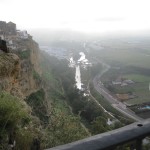
After walking for twenty minutes in the direction she had suggested I remembered how she had run up and down the stairs in the hotel, and realised that she was talking about ten of her minutes, not mine. Archos was larger than Medina and came across to me as much more attractive as I walked along the streets lined with orange trees. Towards the centre the streets narrowed between high stone 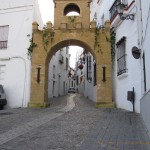 buildings and climbed to a square, one side of which is on the edge of the massive cliff that extends the whole way along the side of the town. The views from here across the valley below are superb.
buildings and climbed to a square, one side of which is on the edge of the massive cliff that extends the whole way along the side of the town. The views from here across the valley below are superb.
The next morning I had another walk round Archos and then set off for Ronda, a much larger picturesque and historically important town, but diverted when I saw a sign to Setenil de las Bodegas. Setenil was described by the RG as having "curious cave-like streets", and it is certainly a quite remarkable place. It is built along a gorge in which the river has eroded the sides away, leaving enormous overhanging cliffs which extend out over the streets. They form the roofs of some of the buildings, and in places stretch right across to buildings on the other side of the road, so that it really does seem that the street is in a cave. Without a map I got lost on foot, and afterwards I looked at the Google maps of Setenil, with a satellite view looking like a pile of worms, unlike anywhere else I have ever seen. As the name suggests this was wine-growing country at one time.
was wine-growing country at one time.
Approaching Ronda from Setenil it seemed a bit like Cheltenham, quite pleasant but not spectacular. I found a small hotel with an underground car park near the town centre, and set off to look round with a map. In fact, the town is very spectacular indeed, being built high on a ridge in the Sierra and split in half by a gorge with sheer sides 130m deep. The most famous feature of the town is the New Bridge, an extraordinary tall, narrow, arched bridge rising up from the bottom of the gorge, and built in the 18th century. This might not seem very new, but it is compared with the other two bridges about ½ mile away, and the gorge itself looks like something from an  old print. Ronda is the home of bullfighting in Spain, and has the oldest bullring in the country. It was not open when I was there, but from the outside it looked surprisingly small, although in fact it is one of the largest around and has a double-tiered seating area supported by stone columns and arches.
old print. Ronda is the home of bullfighting in Spain, and has the oldest bullring in the country. It was not open when I was there, but from the outside it looked surprisingly small, although in fact it is one of the largest around and has a double-tiered seating area supported by stone columns and arches.
From the New Bridge it is a downhill walk to the older and smaller Arab Bridge, from which you can look up into the gorge, another view like an ancient print. In the course of taking photographs here I heard the sound of 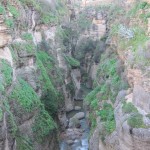 metal striking stone, and looked down to see my nice Seiko watch on the cobbles. The metal bracelet was broken, and although the watch was still going when I picked it up, it stopped shortly afterwards. Fortunately back at the hotel I had the £4 Chinese watch that I wear in places where I think I am going to get mugged.
metal striking stone, and looked down to see my nice Seiko watch on the cobbles. The metal bracelet was broken, and although the watch was still going when I picked it up, it stopped shortly afterwards. Fortunately back at the hotel I had the £4 Chinese watch that I wear in places where I think I am going to get mugged.
The next day was to be dedicated to finding The Scariest Footpath in the World, called the Camino del Rey, which I had no intention of walking along, but just wanted to see. It was a catwalk high up on a sheer cliff face in the El Chorro Gorge, built in the 1920s as part of a hydroelectric power scheme, and was regarded as one of the wonders of Spain until it fell into disrepair. Originally it consisted of a narrow concrete path supported by metal brackets, but the concrete gradually eroded away, leaving holes and eventually in some places just the brackets. People continued to walk the path, but after some deaths it was officially closed and sections at both ends were removed completely to prevent access. There are still organised trips for climbers, using ropes to get down to the path. If you put Camino del Rey into Youtube there is a video made by a man who walked the path holding a video camera pointing downwards, and just stepped from bracket to bracket. Not for the squeamish.
From Ronda the most direct route was on mountain roads across country via El Burgo and Ardales. The EU money had definitely run out by El Burgo, and from there it was more like an Albanian road, with a rough surface, disappearing altogether for one stretch. Ardales, on the side that I approached it, was a strange place, with an unfinished bypass with tape across it, and the only way through appeared to be via incredibly steep, narrow concrete streets. With some trepidation I took one of these, and eventually ended up in a cul-sac at a farm entrance. Nearby was a man putting stuff into a car, and when I asked him the way to El Chorro he did not speak English but indicated that I should follow him in his car. He led me back through the concrete streets and then on a tortuous route round the town, which was much larger than I thought, until we came to the road to El Chorro.
According to the RG the best way to see the Camino del Rey is from the railway that runs alongside the river at the bottom of the gorge, but on foot they describe two ways of getting there, one by walking along railway tunnels. The RG has never quite lost its backpacker roots. Having seen the trains, some of which look like TGVs, I did not think this was a very good idea and chose the alternative way, 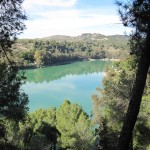 which appeared to be a walk of about two miles on mountain tracks, starting from a restaurant in the valley.
which appeared to be a walk of about two miles on mountain tracks, starting from a restaurant in the valley.
By sheer chance I found the restaurant and had a meal before embarking upon the trek up the mountain. The restaurant overlooked a valley with a dam and reservoirs that had the greenest water I have ever seen, but presumably it does not come out of the taps that colour. The track ran straight up from the car park and appeared to match the description in the RG, with beautiful mountain scenery spoil only by the pylons carrying the cables from the power station below. Apart from a few people going the other way there was no one about, and after walking for almost two hours according to the Chinese watch I felt that I was at the limit of the range 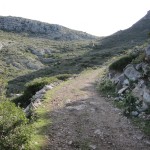 that my knee could stand. The path was still climbing and there was no sign of the gorge or Camino, so now comes the exciting anti-climax - I turned back.
that my knee could stand. The path was still climbing and there was no sign of the gorge or Camino, so now comes the exciting anti-climax - I turned back.
The village of El Chorro was a few miles away, and from there it was possible to see the end of the gorge, but there appeared to be no way of getting to it apart from walking through the railway tunnel. A sign on a minor road in the village stated something that I interpreted as meaning that it led to the gorge, but after climbing for a couple of miles on a narrow winding road past part finished houses in the hills I concluded that it was referring to a residential development. Eventually I found myself at a road junction in the middle of nowhere, and resorted to the satnav, which said I was not on the road at all, but in a field about 200 yards from it. It seemed that the road had been built since the satnav was programmed, which means that it was unlikely that it was more than five years old. It was rather surprising,  therefore, when after about a mile I came to a place where the road had cracked along the middle, and the tarmac and foundations on my side had disappeared completely, leaving a muddy track for about 100 yards. Shortly after this there was a step about 12 inches high in the tarmac right across the road, with a makeshift soil ramp leading to it, and it was obvious that the whole hillside was unstable. Some distance ahead I could see a village in the valley, and turned off towards it. The road ran downhill to a T junction with a muddy track to the right and a "bridge" consisting of a large slab of concrete across a river to the left. There was a piece of tape on the ground indicating that the route was closed, which was not surprising, because the river was like a raging torrent, lapping over the "bridge", and there was a gap of a few yards in the road the other side.
therefore, when after about a mile I came to a place where the road had cracked along the middle, and the tarmac and foundations on my side had disappeared completely, leaving a muddy track for about 100 yards. Shortly after this there was a step about 12 inches high in the tarmac right across the road, with a makeshift soil ramp leading to it, and it was obvious that the whole hillside was unstable. Some distance ahead I could see a village in the valley, and turned off towards it. The road ran downhill to a T junction with a muddy track to the right and a "bridge" consisting of a large slab of concrete across a river to the left. There was a piece of tape on the ground indicating that the route was closed, which was not surprising, because the river was like a raging torrent, lapping over the "bridge", and there was a gap of a few yards in the road the other side.
I was beginning to think I would be spending the rest of my life trapped in the collapsing road network of rural Spain, but after turning back to the last junction and taking the alternative route I eventually came back to civilisation and the satnav recognised where I was.
Over the last two days the weather had become cooler, so I decided to return to the coast and stay in the Flamingo Hotel in Torremolinos, because it was easy. On the morning of the last day I thought I should take a look at the retail scene, and stopped at an out-of-town shopping mall on the outskirts of Fuengirola. It was just like an out-of-town shopping mall anywhere else, with a huge DIY store, a Decathlon sports shop and a Burger King, amongst many other things. From there I went down the road to the splendidly named El Corte Ingleses (The English Cut, referring to gentlemens' suits) a branch of the only remaining department store chain in Spain. This was a very impressive modern building, with a round five-storey glass structure on top of a Hippocor supermarket which is part of the same company. The multi-storey underground car park was an absolute madhouse, but the department store was extremely smart and, again, it was hard to believe that the country was in the grip of a recession.
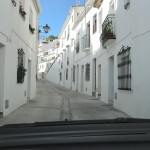 The afternoon was spent looking around Mijas, the nearest traditional village to the big coastal resorts in the area, a quite attractive place despite being very touristy.
The afternoon was spent looking around Mijas, the nearest traditional village to the big coastal resorts in the area, a quite attractive place despite being very touristy.
After all this I still did not know quite what to think about the country. The region, Andalucia, has a lot going for it, good weather, beautiful scenery, nice people, and any visitors should be able to find something to suit their tastes. Shortly after I was there the British Post Office produced a report saying that Spain was one of the cheapest places to go for a holiday, based on a package of items, but I did not think it was particularly cheap, especially for food.
One thing I found surprising was that so many people did not speak English once you get away from the coast, and, as always, I wished I had made a bit more of an effort with the language before going. Also, apart from on a few roads in the mountains, I found driving in Spain to be a fairly miserable experience, with road humps in all urban areas, even on main roads, and massive over-regulation. Spanish drivers were not as bad as I expected, and are certainly very good at handling their vehicles in confined spaces.
It was hard to believe the vast amount of EU money that has been poured into the region. Apart from the new roads all over the place, everywhere you go there are EU supported development projects, but it does not seem to have led to anything. Unemployment in Andalucia as a whole is 28% and in some places like Nerja it is 40%. If Spain stays in the Eurozone it will just be a bottomless pit for this type of investment and it simply doesn't make sense to take money from northern European countries that can compete in the world and give it to southern ones that will never be able to. No British government will have the courage to deal with this, but hopefully the Germans will.